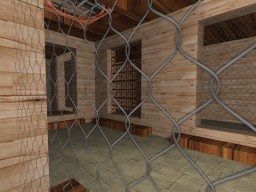More pages: 1 2
New Alpha to coverage demo
Thursday, June 23, 2005 | Permalink
There's a new demo up that demonstrates alpha-to-coverage as a replacement for alpha testing for masked textures when using multisampling. It allows you to compare the quality to alpha testing.
Typhontaur
Saturday, June 25, 2005
Nice! on ati9700 128mb catalyst5.6 - 160-180fps
Good job Humus!

Bj�rn
Sunday, June 26, 2005
Ahh...
Thanks for clearing that up Humus! =)
I think it should be "put in" D3D asap! (Obviously, hehe)
So, developers just neglected this nifty thing in their "babies"? Shame, as you put it, it would make (i.e) FarCry look better on those who cannot supersample.
Keep up the good work Humus!
Jan
Monday, June 27, 2005
Yeah, looks great! And it is so easy to implement.
However, you set AA fixed to 6x. Could you change that, so that i can select 2x, 4x or 6x? Because i would like to play around with those modes and see how it looks then, especially compared to blending.
And technically, it should be faster than blending, but since multisampling is enabled anyway, it shouldn't be slower than alpha-testing, am i right? (although fps show otherwise...)
But why do you disable the alpha-test, when doing alpha-to-coverage? Couldn't that save some fillrate? Or do you do that to enable early z?
Ah, and what if the coverage is 0? Does the depth-value then get written or not?
Thanks,
Jan.
Tan
Friday, July 8, 2005
Hi humus
I got the same problem as Jan described below. Do you have any suggestion?
Thanks
Tan
Humus
Friday, July 8, 2005
Jan, if you want to compare you can simply force the other modes in the control panel instead. As for performance, alpha-to-coverage is usually slower than alpha blending. With alpha-blend all internal pixels will have only a single sample written. With alpha-to-coverage on the other hand all internal edge pixels in the image will be deemed partly covered and have several samples written. So it's more expensive.
I disable alpha test simply because it has nothing extra to offer. With a 0.5 comparison value you you may save some fillrate, but you get half the soft edge cut off, so it looks much worse. To not get that effect you need to compare against 0 or at least a very low value, and in the that case you don't get any performance improvement either since that would map to zero coverage anyway and have no samples written.
The depth value gets written to the samples that are deemed to be covered and visible (depth test pass). With alpha of zero you have no samples covered anyway, so neither color or depth is going to be written. With alpha of 0.5 you get depth written to the three samples that are covered (in 6x AA mode). No difference from color really.
More pages: 1 2



